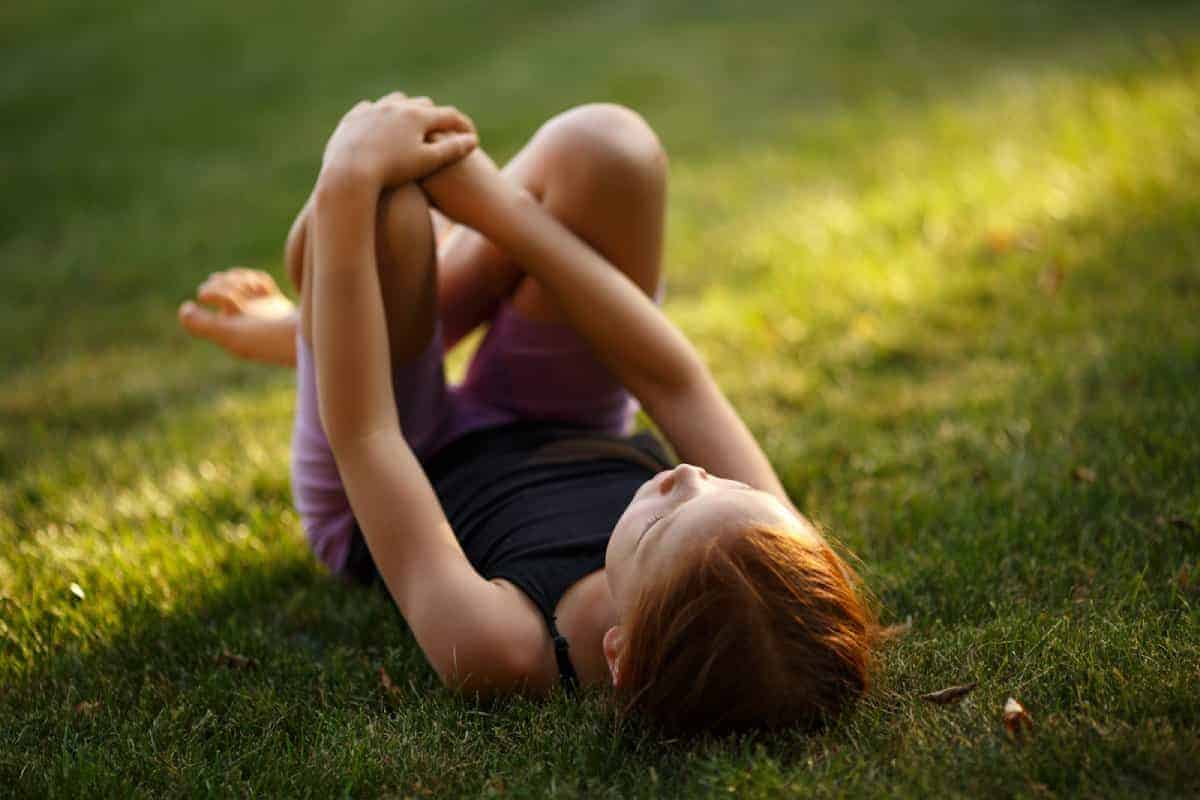Key Takeaway
Discover the joy and benefits of introducing yoga to children, with 20 fun poses that improve focus, emotional management, and confidence, while offering a unique bonding experience for the whole family.
Are you an avid yogi wanting to share this awesome practice with your kids? Or are you a yoga instructor looking to teach to a younger audience?
Yoga is a wonderful practice for people of all ages, including kids. Teaching yoga to kids isn’t tricky, but it requires special considerations. This is because a child’s body, energy levels, and attention span differ significantly from an adult’s.
This guide shares all the top yoga poses for kids and handy tips to get children to start practicing yoga.
Contents
- 1 5 Benefits of Teaching Yoga Poses To Kids
- 2 20 Fun Yoga Poses For Kids
- 2.1 Extended Mountain Pose
- 2.2 Tree Pose
- 2.3 Warrior pose
- 2.4 Peaceful Warrior
- 2.5 Airplane Pose
- 2.6 Half Moon/Super Hero Pose
- 2.7 Eagle Pose
- 2.8 Standing Forward Bend/ Monkey Pose
- 2.9 Chair/Kangaroo Pose
- 2.10 Cat Pose
- 2.11 Cow pose
- 2.12 Snake/Cobra Pose
- 2.13 Lion Pose
- 2.14 Frog Pose
- 2.15 Butterfly Pose
- 2.16 Downward-Facing Dog
- 2.17 Boat Pose
- 2.18 Child’s Pose
- 2.19 Happy Baby Pose
- 2.20 Corpse Pose
- 3 Top Tips For Successful Kids Yoga
- 4 Final Thoughts On Yoga Poses For Kids
5 Benefits of Teaching Yoga Poses To Kids
There are tons of reasons to introduce this practice to your children, such as:
- It improves their concentration skills – Concentration is essential for doing well in school but something most children struggle with. By teaching them yoga, you help expand their ability to focus and teach control and self-discipline.
- It helps them manage their emotions – Yoga is an excellent tool for learning to become more aware of how you feel and control your impulses. Thus, by practicing yoga regularly, kids can experience fewer mood swings, improving their behavior.
- It can make them calmer – Besides reducing anger impulses, yoga is a great way to balance a child’s energy. Practicing yoga can also help kids sleep better at night and feel less anxious in new or challenging situations.
- It boosts their self-confidence – Like all hobbies, yoga gives children feelings of accomplishment and pride, boosting their self-image and confidence.
- It serves as a bonding experience – Practicing yoga together will help to strengthen your relationship and bring your family closer together.
20 Fun Yoga Poses For Kids
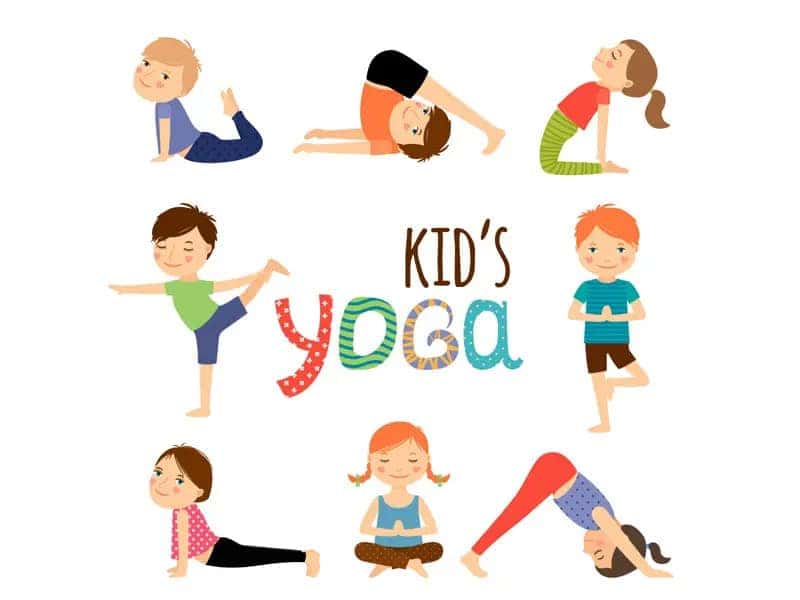
Here are 20 tried-and-tested yoga poses for kids. I recommend teaching them all to your child and seeing which ones they enjoy the most. Then, you can choose their 5/10 favorite yoga poses to create a regular yoga practice.
Extended Mountain Pose
The mountain pose is an ideal yoga pose to start a session with, as it teaches kids how to find balance and stability in their bodies and encourages good posture. In kids’ yoga, I cue them to bring their arms overhead with the palms together to create the shape of a mountain peak.
Suggested cue:
Root your feet into the ground, standing tall and looking up. Reach your arms up to the sky and bring your palms flat together with your elbows bent.
Tree Pose

Tree pose is an enjoyable yoga pose for children, as they love the challenge of standing on one leg. You can also challenge them further by getting them to bring their arms overhead and sway like a tree in the wind.
Suggested cue:
Lift one leg, bend the knee, and place the sole of your foot on your upper or lower leg. Root your other foot firmly into the ground to balance. Bring your palms together at your heart or reach them up to the sky. Stare at one spot in front of you and gently sway from side to side.
Warrior pose
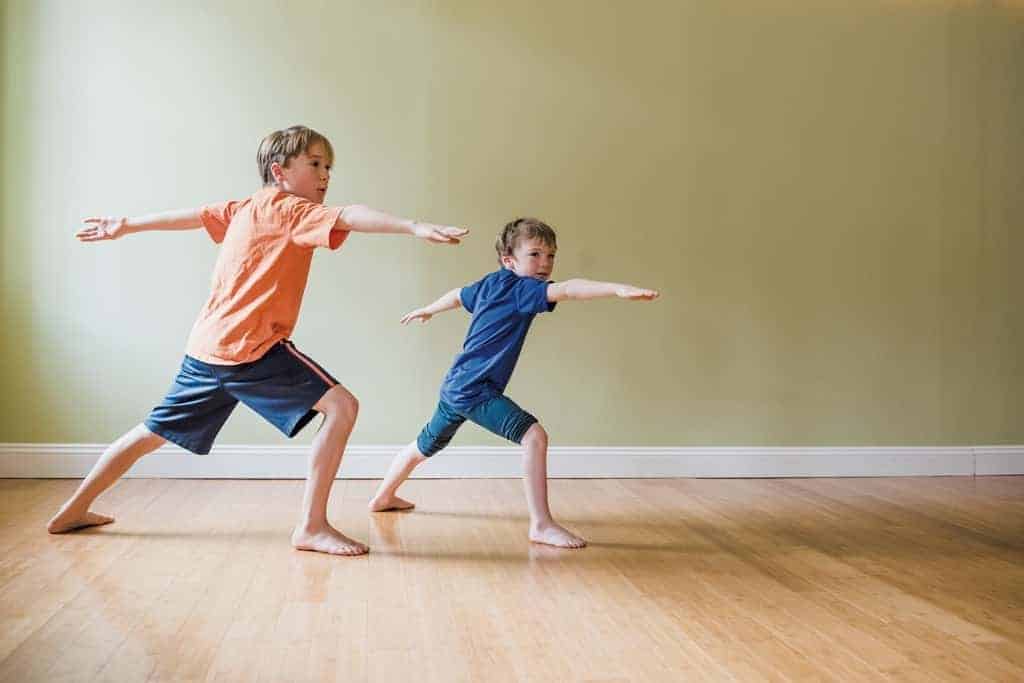
Warrior pose is an excellent posture to teach children, as it encourages them to be strong, brave, and fearless, like a warrior. Like many yoga poses for kids, I change this posture slightly to make it more appealing. First, I cue them into the warrior 2 legs but then I get them to position their arms like they are holding a bow and arrow (like in Standing Archer Pose).
Suggested cue:
From a standing position, step one foot back and turn the toes to face the side. Open your body to the side and bend your front knee.
Press into both feet to create strength, then reach your arms out wide. Create fists with both hands, and then bend your back elbow. Lean back slightly as you raise your front arm, looking at that hand.
Peaceful Warrior
Peaceful warrior goes splendidly with warrior pose, as it teaches kids the other side of being a warrior; the qualities of peacefulness and compassion.
Suggested cue:
From a warrior pose with extended arms, turn your front palm up and reach forward. Sweep the arm up and back and bring your back hand to your back leg. Look up to your top arm.
Airplane Pose
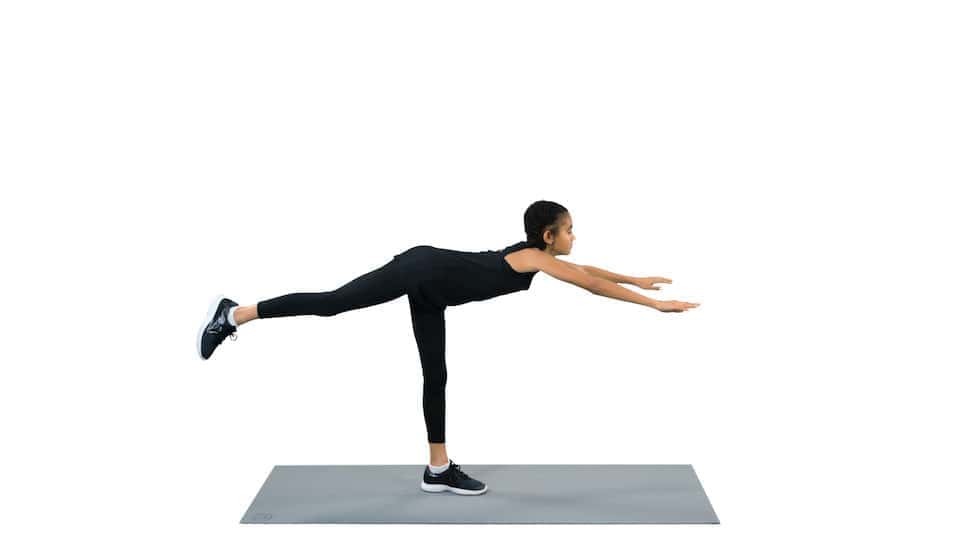
The airplane is another fun balancing yoga pose that improves kids’ body control, strengthens their legs, and enhances confidence and focus.
Suggested cue:
Bring your hands onto your hips from a standing position and shift the weight to one leg. Then, slowly bend forward from your hips while floating your leg behind you. Try to bring your upper body and your floating leg in one straight line, like a balanced see-saw. Then, release your arms and reach them wide like a plane’s wings alongside your body.
Half Moon/Super Hero Pose
Of all the standing asanas, this is one of the hardest but also the most fun. I recommend teaching this yoga pose with a block so they can bring their hand to the block rather than the floor (this will prevent them from falling forward). I like to call this a superhero pose because they feel like they must have special powers to get into it!
Suggested cue:
From the warrior pose, lower your front hand to the block. Next, press into your front foot and slowly lift your back leg until it is parallel to the ground. Keep both legs straight as you reach your top arm up to the sky and look up.
Eagle Pose
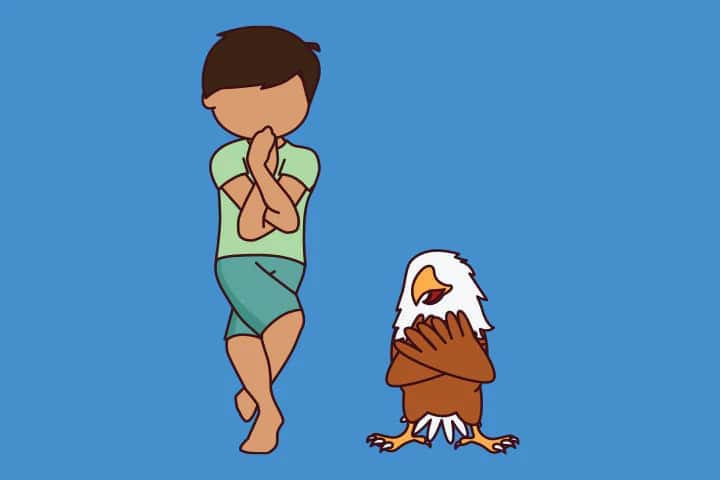
Eagle is excellent for challenging children physically and mentally as they try to balance their bodies and focus their minds.
Suggested cue:
From standing, wrap one leg around the other and bend your knees. Then, with your arms stretched out in front of you, wrap one under the other and bend your elbows. Keep both arms and legs bound as you pretend you are perching on a tree like an eagle looking for prey.
Standing Forward Bend/ Monkey Pose
A standing forward bend is a great yoga pose to include after a series of standing asanas, as it relaxes the body and releases tension.
To make it more exciting, teach it as a monkey pose, getting them to swing their arms from side to side (gorilla noises are optional but encouraged).
Suggested cue:
From a standing position, bring your feet hip-distance apart and your hands onto the hips. Slightly bend your knees, and you fold forward from the hips, bringing your upper body to your legs. Let your arms and head hang heavy, then rock side to side, swinging the arms.
Chair/Kangaroo Pose

One of the most enjoyable yoga poses for kids is to turn the chair pose into a kangaroo pose. The lower body position is the same, but you cue them to bend their elbows and bring their hands to their chest like a kangaroo. You can get them to take a few hops to make it extra fun!
Suggested cue:
Stand tall with your feet hip-width apart. Bend your elbows and bring your hands to your chest like a kangaroo. Bend your knees and sink your hips. Try to hop, keeping your knees bent.
Cat Pose

Cat pose is a great way to warm up and stretch the spine, especially when combined with cow pose. Be sure to teach them how to find a neutral position with the spine before starting, as well as the correct placement of the hands (under the shoulder blades) and knees (under the hips).
Suggested cue:
Come to a tabletop position on all fours. As you breathe out, round your back and tuck your chin into your chest, like a cat taking a big stretch. Meowing is optional but recommended!
Cow pose

While the cat stretches and lengthens the back, the cow gently compresses it to open and stretch the chest. You can alternate between cat and cow a few times for an effective spinal warm-up.
Suggested cue:
Start from tabletop pose with the shoulders over the wrists and hips over the knees. Take a deep breath as you look up, arch your back, and press your chest forward.
Snake/Cobra Pose

The cobra pose is an excellent pose to teach after the cow, as it is a slightly deeper backbend and chest opener. Plus, when you incorporate hissing while holding the pose, it often becomes a favorite!
Suggested cue:
Lay on your stomach with your legs stretched out and your feet together. Place your palms under your shoulders. Inhale as you push into your hands and gently lift your head, chest, and shoulders off the ground. Keep your legs together. Try to lift until your arms are straight, and then hold. As you breathe out, let out a hiss like a snake!
Lion Pose
The lion pose is one of the most popular “animal poses,” because what kid doesn’t want to be a lion? You can do this in various poses, but I like to teach it in a hero pose with wide knees.
Suggested cue:
Sit on your heels with your knees bent and open your knees wide. Place your hands on the ground between your knees, bending forward slightly. Take a deep breath in, then, as you exhale, tilt your head up, arch your back, and open your mouth to release the loudest, scariest roar you can!
Frog Pose

The kids’ yoga version of the frog pose is done in a squat position. As well as opening the hips, this pose requires some lower body strength and builds stamina as it requires them to jump around in the knee-bent position.
Suggested cue:
From standing, open your feet to the width of the mat (or wider than your hips) and turn the toes to face slightly outwards. Then, bend your knees and sink your hips without folding forward.
Extend your arms behind your lower legs with your hands to the floor and lower your bottom as much as possible without lifting the heels off the ground. Then, jump from the back of your mat to the front without straightening your legs. Try to keep the hops as swift and quiet as possible to avoid attracting prey!
Butterfly Pose
The butterfly pose is a cute, peaceful yoga pose popular with girls. As a gentle seated posture, it is best done towards the end of the session and is a lovely way to invite a few moments of calm, quiet, and deep breaths.
Suggested cue:
From sitting, bend your knees and drop them out to the sides so that the soles of your feet touch. Then, place your palms together at your heart and gently flutter your legs up and down as you focus on feeling peace and happiness.
Downward-Facing Dog

Downward-facing dog pose is an excellent full-body stretch and a great way for kids to strengthen their wrists and arms. Like with other animal poses, you can encourage them to connect to their inner dog as they hold this pose by wagging their imaginary tail, letting their tongue hang out, or even barking.
Suggested cue:
Start on your hands and knees in a tabletop position. Tuck your toes and press your hands firmly into the ground with your fingers facing forward and spread wide. Using your arm strength, lift your hips to the sky. With arms and legs straight, try to get your feet flat on the floor and relax your head and neck.
Boat Pose
The boat is among the most challenging yoga poses for kids and adults. It helps children work on their balance and stability and requires immense concentration.
If you teach it to older kids, especially boys, you can tell them this pose will help them build muscles and get a six-pack.
Suggested cue:
From seated, bend your knees, walking your feet in towards you. Grab behind your thighs and sit tall. Slowly float both feet off the ground and lean back slightly, keeping your belly tight. If you feel balanced, reach your arms directly in front of you and extend your legs into a v-shape position.
Child’s Pose
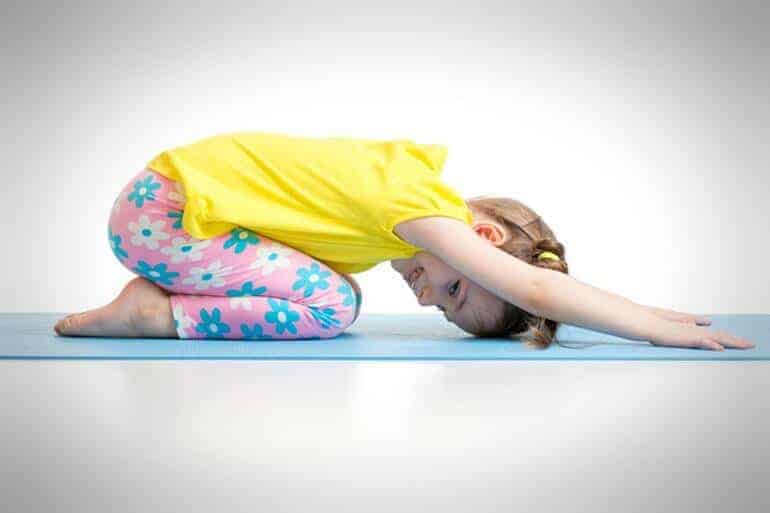
Like in adult yoga classes, the child’s pose is excellent after challenging positions like the boat pose. It relaxes the spine and hips, slows the heart rate, and prevents them from getting too tired.
Suggested cue:
From a kneeling position with your feet relaxed, press your bottom back to your heels and relax your body over your thighs. Then, release your arms out in front of you and rest your forehead on the ground.
Happy Baby Pose
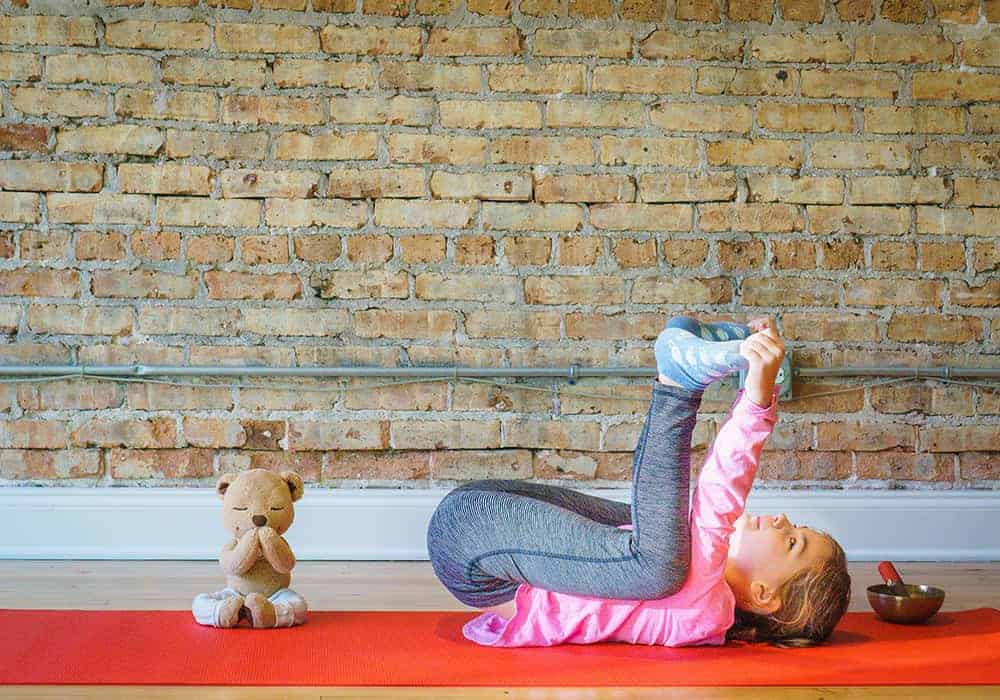
Children, especially younger kids, love the happy baby pose just as much as adults. They enjoy rocking around the floor carelessly, but it is also a challenge as they try to keep hold of their feet. It is also an excellent way to relax the back and open the hips.
Suggested cue:
To do the happy baby pose, lie on your back and hug your knees to your chest. Then, grab the outer side of your feet with both hands and open the knees wide with the soles of the feet facing upwards. Rock side to side like a happy baby.
Corpse Pose
The corpse pose (also known as Savasana) is the final resting pose, where you lay still on your back for a few minutes at the end of a class. After a fun but challenging movement practice, most kids will feel calm enough by this point to lie down and relax for a minute or so.
However, to promote further relaxation, it helps give them a blanket to put over them and a pillow to rest their heads on. This makes it feel more like a mini-nap.
Suggested cue:
Lay down with your legs straight and your arms by your sides. Let your palms open up to the sky, and your feet drop out the side. Relax your entire body and close your eyes. Enjoy this moment of rest as you focus on your breathing.
Top Tips For Successful Kids Yoga

As I previously mentioned, teaching yoga poses to kids is very different from adult yoga. However, from my experience, I have found several tips and tricks that help to make it a successful and enjoyable experience and increase the chances of your child wanting to do yoga regularly. Here are my top suggestions.
Use Affirmations In Each Yoga Pose
One thing I like to include in kids’ yoga is child-friendly affirmations. Children love speaking the affirmations aloud, as it allows them to embody the energy of the shape they are making. Here are some examples:
- Mountain pose – I am strong.
- Warrior pose – I am brave.
- Peaceful warrior – I am peaceful.
- Tree pose – I am kind.
- Half moon pose – I am a superhero.
- Airplane pose – I am limitless.
- Child’s pose – I am calm.
For the animal-inspired poses, you can prompt them to connect to the energy of that animal, such as the courage of a lion, the playfulness of a dog, or the elegance of a butterfly.
Incorporate Yoga Games
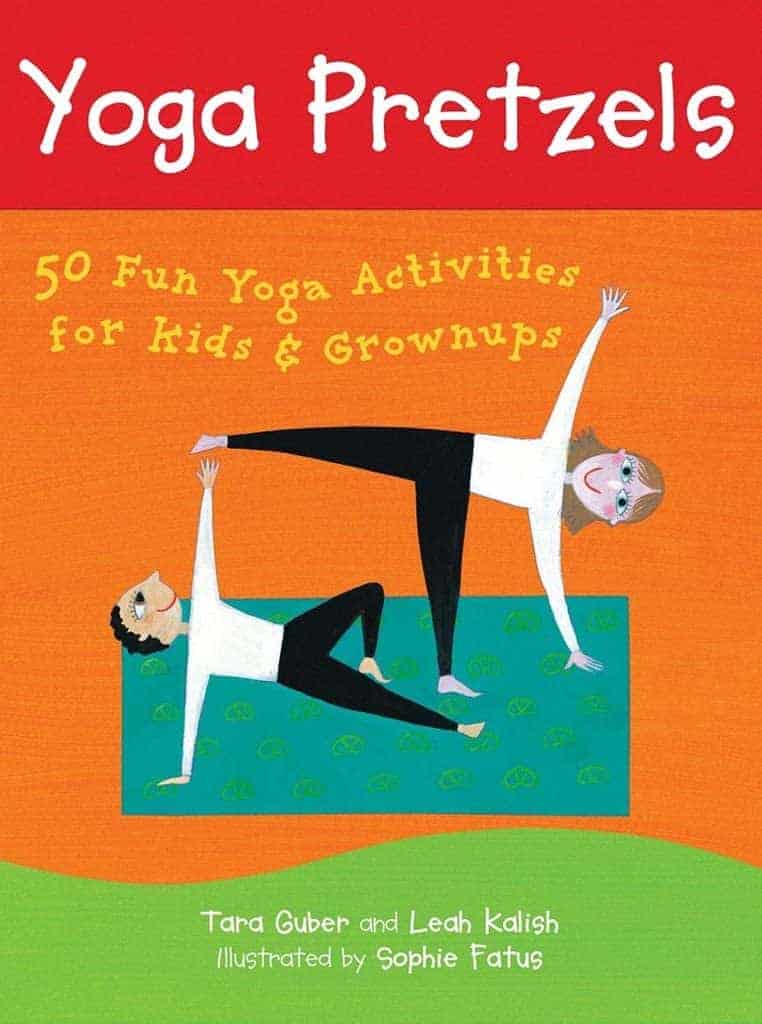
Depending on the child’s age, games can work very well with kids’ yoga poses. Because there are many animal poses, one typical game is to ‘play different animals.’ I do this by teaching them the animal postures and then randomly calling out an animal for them to come into the shape of.
Another great idea is to use a yoga dice like the Covelico Yoga Dice for Kids. The 12-sided foam dice has 11 easy yoga poses for kids like warrior, cobra, and cat, and using it in a yoga session adds an element of surprise. There is also a “pick your own” side, empowering children to create their practice.
For more ideas, I recommend the awesome kid’s yoga deck, Yoga Pretzels. The deck features colorful illustrations of 50 yoga poses and tons of games and activities. There are also ideas for partner yoga activities suitable for adults and children, so the whole family can enjoy yoga’s health benefits.
Teach Meditation And Breathing Exercises
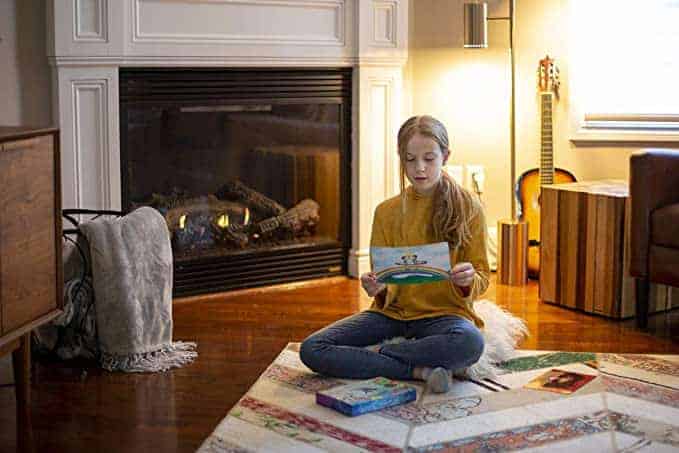
As you know, yoga is not all about postures. Therefore, when teaching yoga to children, it’s essential to include other aspects of the practice, such as breathing and meditation.
Of course, I’m not suggesting teaching difficult pranayamas; instead, keep it simple. For example, I like the start of the class in an easy sitting pose where I teach them how to take a full breath in and out through the nose.
I recommend not keeping them focused on their breathing too long in the beginning, as they are usually full of energy and looking to start moving straight away.
However, by the end of the session, kids are usually much calmer and more settled. So I use the time in the Corpse pose to guide them through taking a few deep breaths. Another thing I like to do in the final resting pose is to take them through a brief body scan where they relax each part of their body, starting from the head and moving to the feet.
For meditation, I like to use the Imagine Meditation Cards for Kids. The deck contains 24 large and colorful cards with short, child-friendly guided meditations.
The meditation instructions are on one side of the card, while the other contains a unique picture. So you can spread the cards out and let your child choose an image they like, then read the guided meditation to them while they lie down at the end of the session.
Final Thoughts On Yoga Poses For Kids
Yoga has many benefits for a child’s physical and mental health and can play a crucial role in their development. Introducing yoga poses for kids can also strengthen the family bond and create a healthy routine that will positively impact their choices as they grow up.


